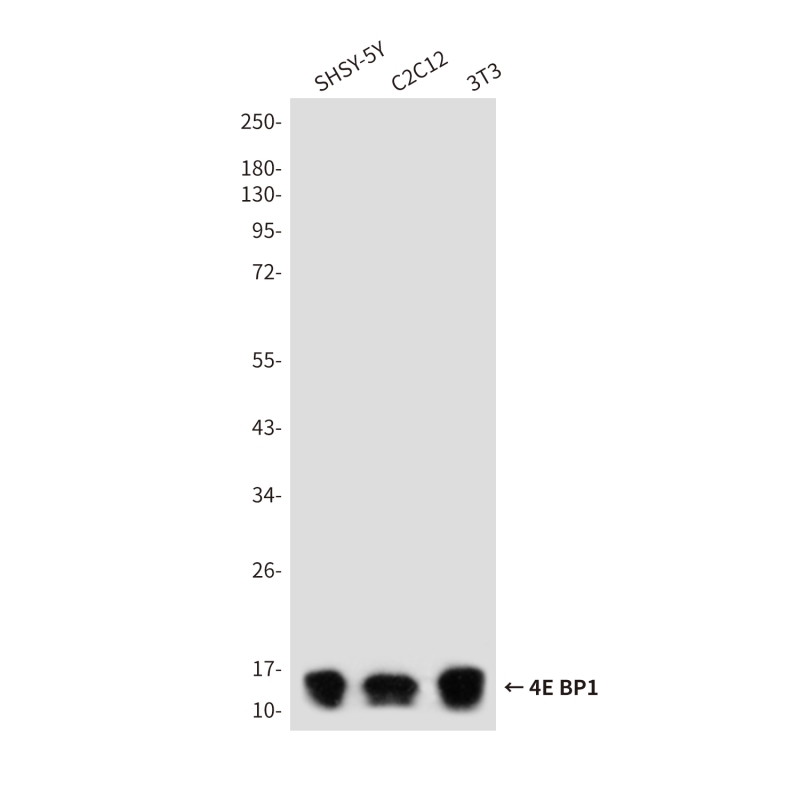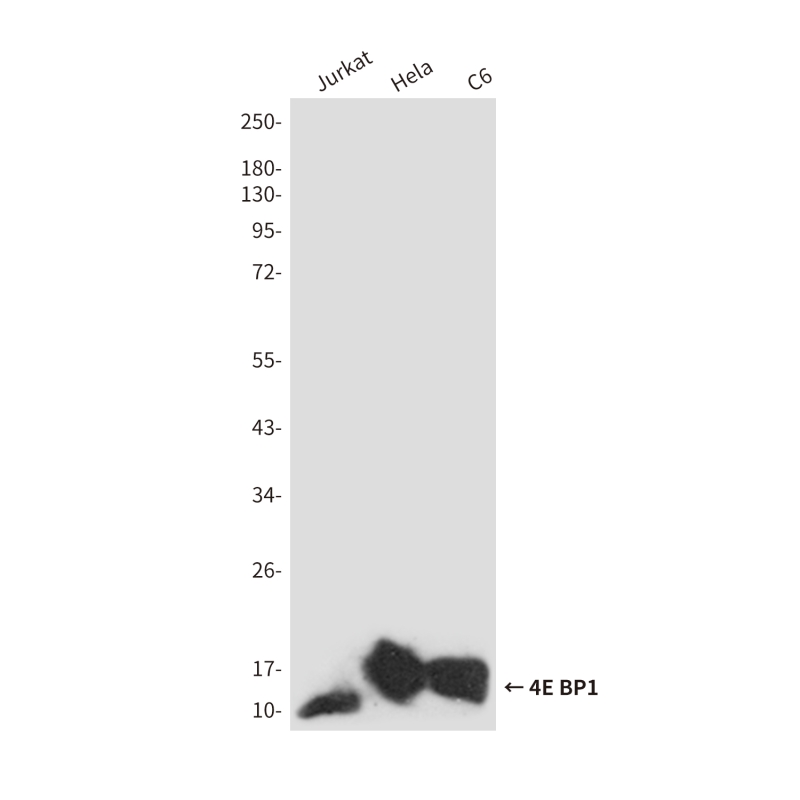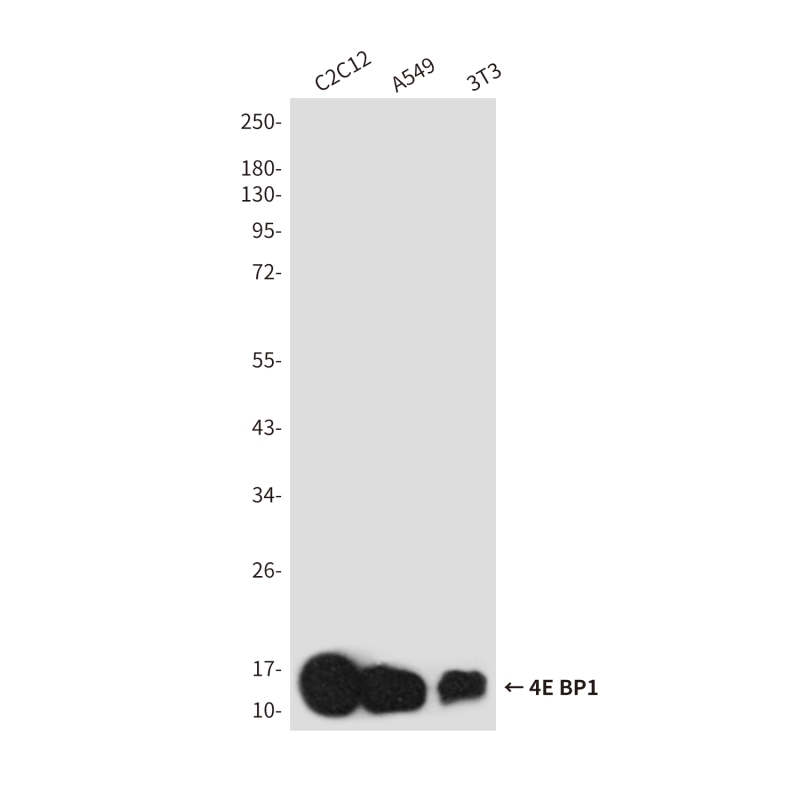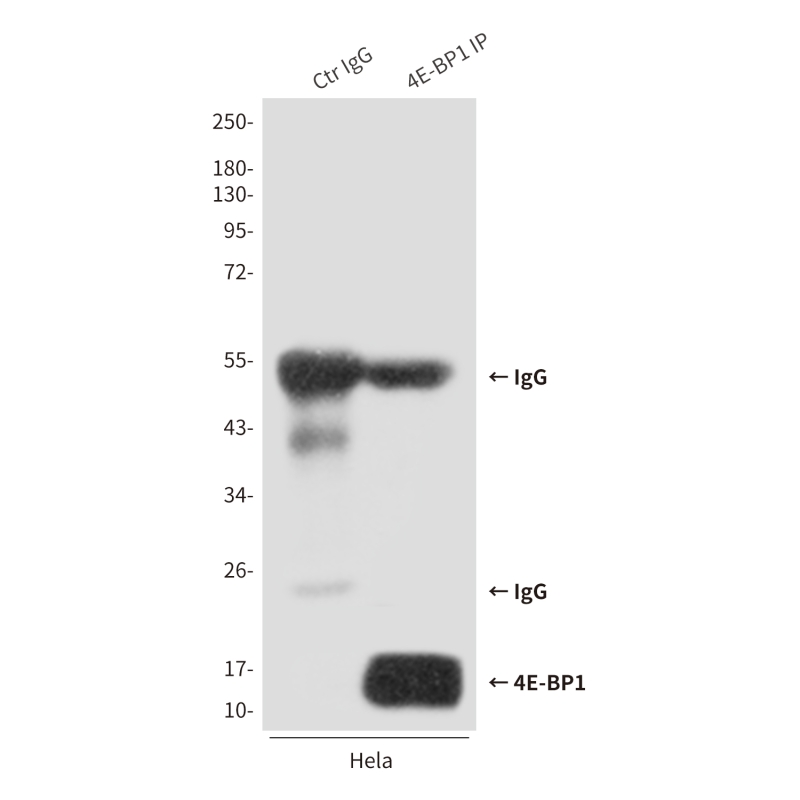



| WB | 咨询技术 | Human,Mouse,Rat |
| IF | 1/20 | Human,Mouse,Rat |
| IHC | 咨询技术 | Human,Mouse,Rat |
| ICC | 技术咨询 | Human,Mouse,Rat |
| FCM | 咨询技术 | Human,Mouse,Rat |
| Elisa | 咨询技术 | Human,Mouse,Rat |
| Aliases | EIF4EBP1; Eukaryotic translation initiation factor 4E-binding protein 1; 4E-BP1; eIF4E-binding protein 1; Phosphorylated heat- and acid-stable protein regulated by insulin 1; PHAS-I |
| Entrez GeneID | 1978 |
| WB Predicted band size | Calculated MW: 13 kDa; Observed MW: 15-20 kDa |
| Host/Isotype | Rabbit IgG |
| Antibody Type | Primary antibody |
| Storage | Store at 4°C short term. Aliquot and store at -20°C long term. Avoid freeze/thaw cycles. |
| Species Reactivity | Human,Mouse,Rat |
| Immunogen | Synthetic peptide. |
| Formulation | Purified antibody in PBS with 0.05% sodium azide,0.5%BSA and 50% glycerol. |
+ +
以下是关于4E-BP1抗体的3篇参考文献示例,涵盖抗体应用、功能验证及疾病研究:
---
1. **文献名称**:*"A monoclonal antibody specific for phosphorylated 4E-BP1 reveals dynamics of mTORC1 signaling in stress responses"*
**作者**:Smith J, et al.
**摘要**:本研究开发了一种针对磷酸化4E-BP1(Thr37/46)的单克隆抗体,验证其在Western blot和免疫荧光中的特异性,并用于追踪mTORC1信号在细胞应激(如营养剥夺)中的动态变化,揭示了4E-BP1磷酸化与翻译抑制的关联。
---
2. **文献名称**:*"Differential roles of 4E-BP1 isoforms in cancer progression revealed by isoform-specific antibodies"*
**作者**:Lee H, et al.
**摘要**:作者团队制备了区分4E-BP1不同剪接变体的抗体,发现某些变体在肿瘤组织中高表达。通过免疫组化分析乳腺癌样本,证实4E-BP1高表达与患者不良预后相关,提示其作为癌症生物标志物的潜力。
---
3. **文献名称**:*"Validation of commercial 4E-BP1 antibodies for translational research in neurodegenerative models"*
**作者**:Garcia M, et al.
**摘要**:系统评估了市售4E-BP1抗体的特异性及适用性,发现部分抗体在阿尔茨海默病小鼠模型中存在非特异性结合。推荐使用克隆号XYZ抗体进行脑组织Western blot,为神经退行性疾病研究提供可靠工具。
---
**备注**:以上文献为示例,实际引用时需通过PubMed或Google Scholar检索真实存在的最新论文,关键词可包括“4E-BP1 antibody validation”、“phospho-4E-BP1 detection”或结合具体研究领域(如癌症、神经科学)。
The 4E-BP1 antibody is a key tool for studying the eukaryotic translation initiation factor 4E-binding protein 1 (4E-BP1), a critical regulator of cap-dependent mRNA translation. 4E-BP1 inhibits the interaction between eIF4E (eukaryotic initiation factor 4E) and eIF4G, components of the translation initiation complex, thereby suppressing protein synthesis. Its activity is modulated by phosphorylation via the mTOR (mechanistic target of rapamycin) signaling pathway, particularly under nutrient-rich or growth-stimulated conditions. Hyperphosphorylation of 4E-BP1 releases eIF4E, enabling translation of mRNAs involved in cell proliferation, survival, and metabolism.
4E-BP1 antibodies are widely used in research to investigate cellular stress responses, cancer biology, and metabolic disorders. They detect total 4E-BP1 protein levels or specific phosphorylation states (e.g., Thr37/46. Ser65), providing insights into mTOR pathway activation. Dysregulation of 4E-BP1 phosphorylation is implicated in tumorigenesis, neurodegenerative diseases, and insulin resistance. Available as monoclonal or polyclonal variants from various species (e.g., rabbit, mouse), these antibodies are validated for techniques like Western blotting, immunoprecipitation, and immunofluorescence. Their specificity and sensitivity make them essential for elucidating translational control mechanisms in both physiological and pathological contexts.
×